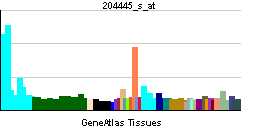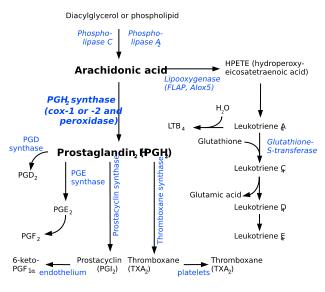Arachidonate 5-lipoxygenase: Difference between revisions
m (Bot: Automated text replacement (-{{SIB}} + & -{{EH}} + & -{{EJ}} + & -{{Editor Help}} + & -{{Editor Join}} +)) |
m (Robot: Automated text replacement (-{{WikiDoc Cardiology Network Infobox}} +, -<references /> +{{reflist|2}}, -{{reflist}} +{{reflist|2}})) |
||
| Line 80: | Line 80: | ||
==References== | ==References== | ||
{{reflist}} | {{reflist|2}} | ||
==Further reading== | ==Further reading== | ||
Revision as of 14:27, 4 September 2012
| Arachidonate 5-lipoxygenase | |||||||||||
|---|---|---|---|---|---|---|---|---|---|---|---|
| Identifiers | |||||||||||
| Symbols | ALOX5 ; 5-LO; 5LPG; LOG5; MGC163204 | ||||||||||
| External IDs | Template:OMIM5 Template:MGI HomoloGene: 561 | ||||||||||
| |||||||||||
| RNA expression pattern | |||||||||||
 | |||||||||||
 | |||||||||||
 | |||||||||||
| More reference expression data | |||||||||||
| Orthologs | |||||||||||
| Template:GNF Ortholog box | |||||||||||
| Species | Human | Mouse | |||||||||
| Entrez | n/a | n/a | |||||||||
| Ensembl | n/a | n/a | |||||||||
| UniProt | n/a | n/a | |||||||||
| RefSeq (mRNA) | n/a | n/a | |||||||||
| RefSeq (protein) | n/a | n/a | |||||||||
| Location (UCSC) | n/a | n/a | |||||||||
| PubMed search | n/a | n/a | |||||||||
Arachidonate 5-lipoxygenase (5-lipoxygenase, 5-LO or Alox5) is a human enzyme, member of the lipoxygenase family. It transforms EFAs into leukotrienes and is a current target for pharmaceutical intervention in a number of diseases.
Substrates and products
EFA substrates and leukotriene products of 5-LO include:
- Arachidonic acid (AA) yields the 4-series leukotrienes (LTB4, LTC4, LTD4, LTE4 — generally proinflammatory)
- Eicosapentaenoic acid (EPA) yields the 5-series (LTB5, LTC5, LTD5, LTE5 — antiinflammatory)
- Gamma-linolenic acid (GLA via the DGLA intermediary) yields no leukotrienes, but inhibits the conversion of AA.
Functions
5-LO catalyzes oxidation of AA at the 5-position to yield 5-hydroperoxyeicosatetraenoic acid (5-HPETE). 5-LO then converts 5-HPETE to leukotriene A4.[1]

Two other lipoxygenases, 12-LO and 15-LO, act at the 12- and 15-positions, yielding 12- and 15-HPETE. These pathways lead to the leukotriene 12-hydroxyeicosatetraenoic acid (12-HETE) and to the lipoxins, respectively.[2]
Clinical significance
5-LO is a target for pharmaceutical intervention in CAD.[3] Some people with variant alleles for 5-LO are at elevated risk for CAD.[4] 5-LO is expressed in brain cells and may participate in neuropathologic processes.[5]
Mutations in the promoter region of this gene lead to a diminished response to antileukotriene drugs used in the treatment of asthma and may also be associated with atherosclerosis and several cancers. Alternatively spliced transcript variants have been observed, but their full-length nature has not been determined.[6]
5-LO inhibitors
As leukotrienes are important causes of pathological symptoms in asthma, 5-LO inhibitors were developed as asthma treatments. The only 5-LO inhibitor currently licensed for human use in asthma is Zileuton.
Minocycline, although primarily a tetracycline antibiotic, is also a 5-LO inhibitor.[7] It may therefore be used as a DMARD-medication in mild rheumatoid arthritis and other rheumatic conditions. [8]
Activation
5-LO is activated by 5-lipoxygenase activating protein (FLAP).
References
- ↑ Reaction R01595 and R03058 at KEGG Pathway Database.
- ↑ Dorlands Medical Dictionary, entries at arachidonate 5-lipoxygenase and following. Retrieved on 2006-02-07.
- ↑ "5-Lipoxygenase, A New Therapeutic And Diagnostic Target For Heart Disease Management". UCLA Case No. 2001-429 PCT Publication Number: WO 03/035670 A2. Archived from the original on 2006-08-30. Retrieved 2007-11-18.
- ↑ Dwyer JH, Allayee H, Dwyer KM; et al. (2004). "Arachidonate 5-lipoxygenase promoter genotype, dietary arachidonic acid, and atherosclerosis". N. Engl. J. Med. 350 (1): 29–37. doi:10.1056/NEJMoa025079. PMID 14702425.
- ↑ Zhang L, Zhang WP, Hu H; et al. (2006). "Expression patterns of 5-lipoxygenase in human brain with traumatic injury and astrocytoma". Neuropathology : official journal of the Japanese Society of Neuropathology. 26 (2): 99–106. doi:10.1111/j.1440-1789.2006.00658.x. PMID 16708542.
- ↑ "Entrez Gene: ALOX5 arachidonate 5-lipoxygenase".
- ↑ Song Y, Wei EQ, Zhang WP, Zhang L, Liu JR, Chen Z (2004). "Minocycline protects PC12 cells from ischemic-like injury and inhibits 5-lipoxygenase activation". Neuroreport. 15 (14): 2181–4. PMID 15371729.
- ↑ arthritis.about.com: Minocin - Minocycline - Dosage - Side Effects - Drug Interactions
Further reading
- Rådmark OP (2000). "The molecular biology and regulation of 5-lipoxygenase". Am. J. Respir. Crit. Care Med. 161 (2 Pt 2): S11–5. PMID 10673219.
- Hammarberg T, Reddy KV, Persson B, Rådmark O (2003). "Calcium binding to 5-lipoxygenase". Adv. Exp. Med. Biol. 507: 117–21. PMID 12664574.
- Ishii S, Noguchi M, Miyano M; et al. (1992). "Mutagenesis studies on the amino acid residues involved in the iron-binding and the activity of human 5-lipoxygenase". Biochem. Biophys. Res. Commun. 182 (3): 1482–90. PMID 1540191.
- Nguyen T, Falgueyret JP, Abramovitz M, Riendeau D (1991). "Evaluation of the role of conserved His and Met residues among lipoxygenases by site-directed mutagenesis of recombinant human 5-lipoxygenase". J. Biol. Chem. 266 (32): 22057–62. PMID 1939225.
- Hoshiko S, Rådmark O, Samuelsson B (1991). "Characterization of the human 5-lipoxygenase gene promoter". Proc. Natl. Acad. Sci. U.S.A. 87 (23): 9073–7. PMID 2251250.
- Funk CD, Hoshiko S, Matsumoto T; et al. (1989). "Characterization of the human 5-lipoxygenase gene". Proc. Natl. Acad. Sci. U.S.A. 86 (8): 2587–91. PMID 2565035.
- Matsumoto T, Funk CD, Rådmark O; et al. (1988). "Molecular cloning and amino acid sequence of human 5-lipoxygenase". Proc. Natl. Acad. Sci. U.S.A. 85 (1): 26–30. PMID 2829172.
- Rouzer CA, Kargman S (1988). "Translocation of 5-lipoxygenase to the membrane in human leukocytes challenged with ionophore A23187". J. Biol. Chem. 263 (22): 10980–8. PMID 3134355.
- Dixon RA, Jones RE, Diehl RE; et al. (1988). "Cloning of the cDNA for human 5-lipoxygenase". Proc. Natl. Acad. Sci. U.S.A. 85 (2): 416–20. PMID 3422434.
- Jakobsson PJ, Shaskin P, Larsson P; et al. (1995). "Studies on the regulation and localization of 5-lipoxygenase in human B-lymphocytes". Eur. J. Biochem. 232 (1): 37–46. PMID 7556168.
- Janssen-Timmen U, Vickers PJ, Wittig U; et al. (1995). "Expression of 5-lipoxygenase in differentiating human skin keratinocytes". Proc. Natl. Acad. Sci. U.S.A. 92 (15): 6966–70. PMID 7624354.
- Lepley RA, Fitzpatrick FA (1994). "5-Lipoxygenase contains a functional Src homology 3-binding motif that interacts with the Src homology 3 domain of Grb2 and cytoskeletal proteins". J. Biol. Chem. 269 (39): 24163–8. PMID 7929073.
- Shaw KJ, Ng C, Kovacs BW (1994). "Cyclooxygenase gene expression in human endometrium and decidua". Prostaglandins Leukot. Essent. Fatty Acids. 50 (5): 239–43. PMID 8066098.
- Maruyama K, Sugano S (1994). "Oligo-capping: a simple method to replace the cap structure of eukaryotic mRNAs with oligoribonucleotides". Gene. 138 (1–2): 171–4. PMID 8125298.
- Woods JW, Evans JF, Ethier D; et al. (1993). "5-lipoxygenase and 5-lipoxygenase-activating protein are localized in the nuclear envelope of activated human leukocytes". J. Exp. Med. 178 (6): 1935–46. PMID 8245774.
- Mancini JA, Li C, Vickers PJ (1994). "5-Lipoxygenase activity in the human pancreas". Journal of lipid mediators. 8 (3): 145–50. PMID 8268460.
- VanderNoot VA, Fitzpatrick FA (1996). "Competitive binding assay of src homology domain 3 interactions between 5-lipoxygenase and growth factor receptor binding protein 2". Anal. Biochem. 230 (1): 108–14. doi:10.1006/abio.1995.1444. PMID 8585605.
- Brock TG, McNish RW, Bailie MB, Peters-Golden M (1997). "Rapid import of cytosolic 5-lipoxygenase into the nucleus of neutrophils after in vivo recruitment and in vitro adherence". J. Biol. Chem. 272 (13): 8276–80. PMID 9079648.
- Nassar GM, Montero A, Fukunaga M, Badr KF (1997). "Contrasting effects of proinflammatory and T-helper lymphocyte subset-2 cytokines on the 5-lipoxygenase pathway in monocytes". Kidney Int. 51 (5): 1520–8. PMID 9150468.
- Suzuki Y, Yoshitomo-Nakagawa K, Maruyama K; et al. (1997). "Construction and characterization of a full length-enriched and a 5'-end-enriched cDNA library". Gene. 200 (1–2): 149–56. PMID 9373149.
External links
- Arachidonate+5-Lipoxygenase at the US National Library of Medicine Medical Subject Headings (MeSH)